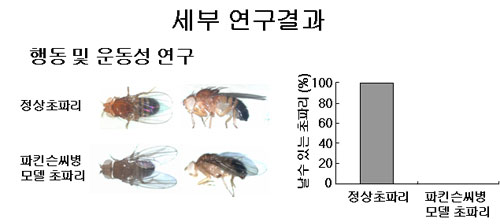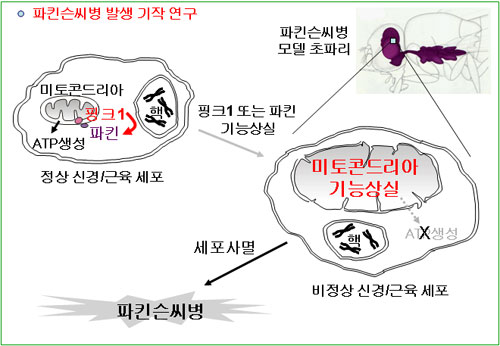

LOS ANGELES, May 4 (UPI) -- U.S. and South Korean scientists say they've found a mutant protein implicated in inherited Parkinson's disease that disables the cell's mitochondria.
The finding by Ming Guo of the University of California-Los Angeles and Jongkyeong Chung of the Korea Advanced Institute of Science and Technology underscores the importance of the energy-generating organelles in the neurodegenerative disorder, researchers said.
Previously, scientists had shown a familial form of Parkinson's that strikes early in life is caused by mutations in the PTEN-induced putative kinase 1, or PINK1, gene. Now Ming and Chung have explored what the gene does by studying the equivalent gene in the fruit fly, Drosophila.
Their teams found flies without a functional PINK1 gene suffer defects in mitochondria that appear to trigger muscle problems and, Chung's team reported, degeneration of dopaminergic neurons.
The research also showed the PINK1 protein acts upstream of Parkin, another molecule underlying sporadic forms of Parkinson's -- and that the two proteins most likely act in a common pathway involved in maintaining mitochondrial function.
The study appears online in advance of publication in the journal Nature.
++++++++++++++++++++++++++++++++++++++++++++++++++++++++++++++++++++++++++++++++++++++++++++++
Gene Linked to Parkinson's Cripples Mitochondria
May 3, 2006
(The New York Times News Service) -- In a breakthrough that may eventually lead to new ways to treat Parkinson's disease, two independent research groups have found that a gene linked to inherited Parkinson's works by disabling a cell's mitochondria.
Mitochondria are the power centers of the cells. They are structures within cells that provide the energy a cell needs to move, divide and produce proteins.
In earlier studies, researchers had found that inherited Parkinson's is caused by mutations in the PTEN-induced putative kinase 1 or PINK1 gene.
Parkinson's disease is a progressive disorder caused by degeneration of nerve cells in the part of the brain that controls movement. First described as "the shaking palsy" in 1817, it affects an estimated 500,000 Americans, with 50,000 new cases reported each year. It is the second most common neurodegenerative disease; only Alzheimer's strikes more people.
The two reports appear in the May 3 online issue of Nature.
Both research teams showed that flies without a functional PINK1 gene have defects in mitochondria that trigger muscle problems and, according to one team, degeneration of neurons that produce dopamine.
In addition, both research groups showed that the PINK1 protein acts upstream of Parkin, another protein linked to the sporadic forms of Parkinson's. These two proteins appear to act in a common pathway involved in maintaining mitochondrial function.
"We found that when you remove PINK 1, the animals are alive, but they have defects in mitochondria," says lead author of the first report Dr. Ming Guo, an assistant professor of neurology at UCLA. "In addition, we found that Parkin and PINK 1 function in the same pathway."
In the second report, Korean researchers had similar findings.
"Our study, using Drosophila (fruit fly) model, revealed that two distinct gene products, Parkin and PINK1, converge in a common pathway in maintaining mitochondrial integrity and function in both muscles and dopamine neurons," says lead researcher Jongkyeong Chung, an associate professor in the Department of Biological Sciences at the Korea Advanced Institute of Science and Technology.
"This clearly suggests that mitochondrial failure is the central mechanism in the pathogenesis of Parkinson's disease," Chung says. "Our findings indicate that there may be a specific molecular target in the PINK1-Parkin pathway. We believe that identification of this target will bring significant insight into basic and clinical science to develop effective drugs for Parkinson's disease."
There may be clinical implications to this finding, Guo confirms. "If we understand how the disease is brought on, it will help us develop more therapies," she says. "If we can find drugs that can rescue these mitochondrial functions, that would be a much better drug than the current therapies that are targeted on dopamine replacement."
However, one expert doesn't think these findings will have any implications for treatment in the near future.
"These findings probably won't have any immediate impact on treatment," says Dr. Jon Stoessl, director of the Pacific Parkinson's Research Center at the University of British Columbia, in Canada.
"You can never be sure there will be a direct therapeutic link in studies done in animal models," he adds. "Because people have already suggested that mitochondrial function is important in Parkinson's, this is not going to suggest a novel approach to treatment, but it will strengthen the importance of searching for treatments along these lines."
Copyright 2006 The New York Times News Service. All rights reserved.
++++++++++++++++++++++++++++++++++++++++++++++++++++++++++++++++++++++++++++++++++++++++++
파킨슨씨병 치료의 길 열릴까?
KAIST 정종경 교수팀, 유전적인 메커니즘 규명
▲ KAIST 정종경 교수. ⓒ
최고의 복서로 시대를 풍미했던 미국의 권투선수 무하마드 알리, 중국 대륙을 움직였던 작은 거인 덩샤오핑, 가톨릭교회의 최고 지도자였던 교황 요한 바오로 2세, 그리고 영화배우인 캐서린 헵번과 마이클 J 폭스…. 이들의 공통점은 퇴행성 뇌질환인 파킨슨씨병을 앓았다는 점이다.
파킨슨씨병은 치매에 이어 두 번째로 빈번하게 유발되는 퇴행성뇌질환으로 노인 100명당 1명꼴로 나타난다. 그러나 현재까지 정확한 질병 발생 원인이 알려져 있지 않아 효과적인 치료제 개발이 미흡한 상태다. 단기적으로 증상을 완화하는 치료제만 개발돼 있어 일단 발병하면 시간 문제가 되는 안타까운 상황이었던 것이다.
이런 상황에서 국내 과학자가 파킨슨씨병의 발병과 관련된 유전적인 메커니즘을 세계 최초로 규명하면서 정말 인류가 파킨슨씨병을 치료할 방법을 찾아낼 수 있을지 관심이 집중되고 있다. KAIST 정종경 교수팀은 바이오벤처기업인 (주)제넥셀, 충남대 의대와 협력해 파킨슨씨병 핵심 발병원인 유전자인 '파킨'(Parkin)과 ‘핑크1’(PINK1)의 기능과 상호작용을 밝혀 세계적인 과학저널 네이처 5월 4일자에 발표했다.
정종경 교수팀이 거둔 성과는 크게 두 가지로 나눌 수 있다. 우선 파킨슨씨병이라는 미지의 병의 유전적인 메커니즘을 규명한 것. 연구팀은 파킨슨씨병과 관련된 것으로 알려진 10여 개의 유전자 중 핑크1에서 파킨으로 이어지는 유전자의 명령체계에 문제가 발생하면 파킨슨씨병이 발생한다는 사실을 알아내는 데 성공했다.
▲ 연구팀이 만든 파킨슨씨병 초파리는 날개가 굽었으며 날 수도 없다. ⓒ
▲ 파킨슨씨병 발명 메커니즘. 유전자에 문제가 생기면 미토콘드리아 기능을 상실시켜 병이 발생한다. ⓒ
특히 두 유전자가 도파민 뇌신경세포와 근육세포 내에서 ‘미토콘드리아’라는 세포소기관의 정상적인 기능유지에 필요하다는 점을 밝혔다. 이들 유전자가 망가질 경우 급격한 미토콘드리아의 변형과 파괴가 일어나며 결과적으로 파킨슨씨병이 유발됨을 알아낸 것이다. 미토콘드리아의 변형이 파킨슨씨병과 관련돼 있다는 점은 이미 알려져 있었는데, 지금까지 병의 원인인지 결과인지 불분명했었다.
두 번째 성과는 치료제 개발의 구체적인 타켓을 제공했다는 점이다. 실제 정 교수팀은 파킨이 미토콘드리아 기능을 상실시키는 중간 과정을 타켓으로 설정, 이 부분을 막는 신약 후보물질을 이미 찾아낸 것으로 알려지고 있다. 초파리나 세포 수준에서의 치료효과를 확인했다는 후문이다.
정 교수팀은 세계적인 논문 발표와 후보물질 발굴이라는 커다란 성과를 거뒀지만 앞으로 해결해야 할 문제가 한두 가지가 아니다. 가장 중요한 문제는 연구팀이 초파리를 대상으로 유전자를 밝히고 치료물질을 찾아냈는데 과연 인간도 똑같겠느냐는 것.
정 교수는 “살아 있는 인간의 뇌 조직을 떼어내 실험을 할 수 없기 때문에 동물 연구는 필수적”이라면서 “쥐를 대상으로도 실험해 봤는데 쥐보다 오히려 초파리가 인간의 파킨슨씨병과 유사한 점이 더 많은 것 같다”고 주장했다. 그러나 이 얘기는 결국 비슷한 것 같다는 주장이지 결코 똑같다는 얘기는 아니다.
또 한 가지 문제는 파킨슨씨병 환자 중 유전적인 원인에 의해 발병하는 것은 불과 10%에 지나지 않는다는 점이다. 정 교수는 “파킨슨씨병 환자의 경우 유전적인 원인으로 발생하는 경우와 환경적인 원인으로 발생하는 경우 병리적인 증상이 아주 흡사하기 때문에 서로 밀접히 관련돼 있을 것”이라고 주장하고 있으나 이 역시 좀더 연구를 진행해 봐야 결과를 알 수 있을 전망이다.
이번 연구성과가 파킨슨씨병을 치료하는 새로운 길을 제시한 것은 분명한 사실이다. 그러나 그 길을 따라 걸어갔을 때 정말 파킨슨씨병을 치료할 수 있을지는 좀더 두고봐야 할 전망이다.
/김홍재 기자 ecos@ksf.or.kr



 1
1 
